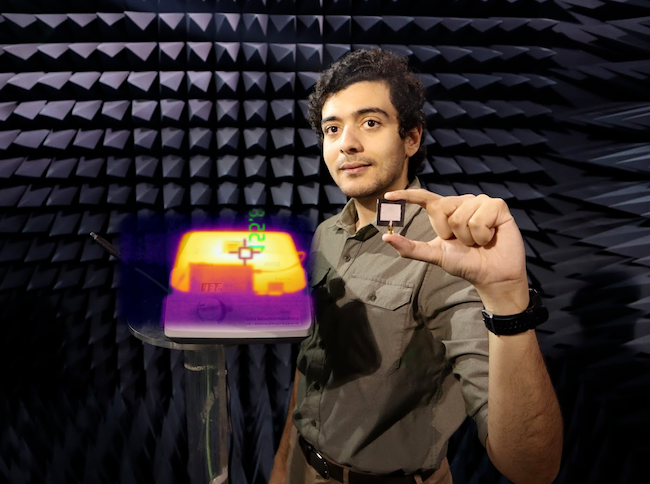Engineers from UK institutions have created a novel way to measure temperature using electromagnetic waves to interact with a flexible and soft "smart skin" sensor. The researchers created a composite carbon fiber and silicon rubber sensor that runs without batteries or onboard processing.

Image Credit: University of Glasgow
Compared to similar devices, the flexible sensor's capacity to absorb and reflect radio-frequency (RF) signals varies with atmospheric heat or cold, allowing temperature measurement across a far wider range. It can also resist thousands of cycles of bending and stretching without losing its sensitivity to temperature.
Nearly every electronic equipment has a temperature sensor, and the $5–$8 billion global market for this technology is currently in place.
Thermistors, commonly known as temperature sensors, function by altering resistance in response to temperature changes.
Temperature sensors, however, typically rely on a variety of different thermistors to cover a wide sensing range because they are only able to measure over limited ranges of temperature variation.
The University of Glasgow researchers headed the team that created the novel soft, flexible temperature sensor, which can read temperatures over a record-breaking range of 30 °C to more than 200 °C. This could lead to future wireless sensors being more affordable and environmentally friendly because fewer devices will be needed to detect temperatures within the same range.
The researchers demonstrated how they molded the flexible material using a 3D printer and incorporated it into parts like antennae, RFID labels, and resonators in a report published in the journal Nature Communications. After that, they conducted tests to see how well it could absorb radiofrequency (RF) radiation at various temperatures—up to 300 °C.
Sensors are the main interface between the analog world and smart devizes. To communicate real-world changes in measurements like temperature or humidity to wireless smart devices, those measurements first need to be digitized.
Dr. Mahmoud Wagih, Lecturer and UK IC Research Fellow, The University of Glasgow
Mahmoud Wagih said, “We designed a simple soft composite using common silicone and carbon fibers, which can be easily molded into any shape. These skin-like substrates could be used to design antennas over large areas, which can then radiate signals that are highly sensitive to temperature changes.”
Many researchers have used RF and microwave devices to measure liquid formulations, temperature, humidity, and other physical and chemical parameters. However, this level of sensitivity has not been demonstrated before.
Dr. Mahmoud Wagih, Lecturer and UK IC Research Fellow, The University of Glasgow.
Southampton University researchers aided the development of the stretchable and flexible sensor material, which could be effortlessly incorporated into smart fabrics and bending electronics. The material's ability to be twisted and stretched for thousands of cycles without noticeably altering its reaction is demonstrated in the study.
Loughborough University collaborators sought to characterize the electrical properties of the novel material and show that it operated inside the range of 5G communications technology up to a frequency of 26 GHz.
The researchers proposed that the composite might be further engineered to increase or decrease sensitivity to particular wireless signals due to its "anisotropic" features, which alter the material's interaction with electric fields in different directions.
Radar sensing, satellite communications, 6G wireless networks, and vital sign monitoring are just a few potential future uses for this technology.
With funding from the UK Engineering and Physical Sciences Research Council (EPSRC), Dr. Wagih is currently in charge of a new research project that will expand on previous findings to identify new uses for biodegradable and sustainable wireless devices.
We are delighted to start further research on functional and natively stretchable materials for body-centric wireless sensing, building on our track record in cutting-edge RF sensing. The UK is already a leader in applied microwave engineering and advanced materials, and we hope that collaborative research like this will help lead to results that can find commercial applications.
Dr. Mahmoud Wagih, Lecturer and UK IC Research Fellow, The University of Glasgow.
Researchers from the Universities of Glasgow, Southampton, and Loughborough with PragmatIC Semiconductor Ltd. in Cambridge also contributed to the paper.
The research was funded by the UK Engineering and Physical Sciences Research Council (EPSRC), the Royal Society, the Royal Academy of Engineering, and the Office of the Chief Science Adviser for National Security.
Researchers turn up the heat on flexible temperature sensor development using microwaves
Video Credit: University of Glasgow
Journal Reference:
Wagih, M., et al. (2024). Wide-range soft anisotropic thermistor with a direct wireless radio frequency interface. Nature Communication. doi.org/10.1038/s41467-024-44735-z
Source: https://www.gla.ac.uk/